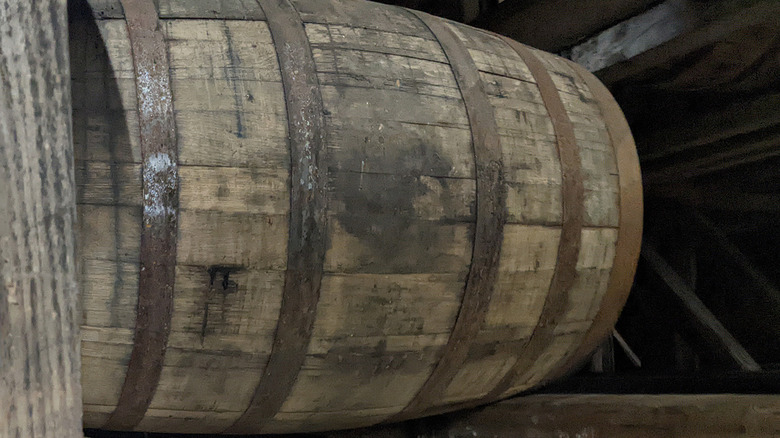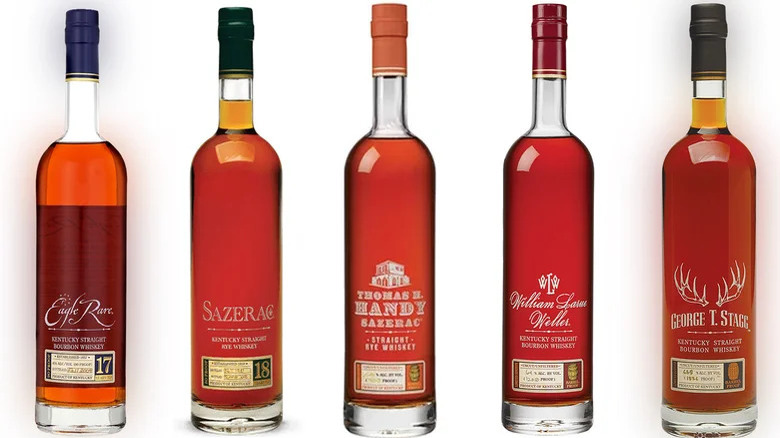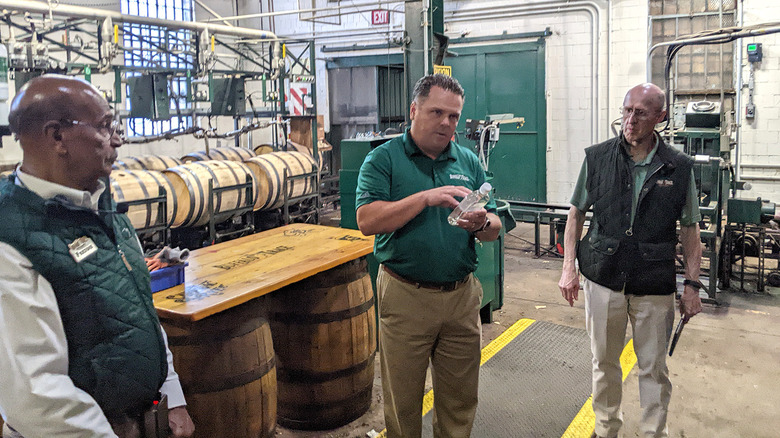Your Ultimate Guide To Buffalo Trace's Coveted Antique Collection
If you're a whiskey dilettante (and that's fine!) you might have heard a thing or two about the highly regarded Buffalo Trace Antique Collection, or BTAC ("Bee-tack") as it's sometimes called for short. These ultra-premium bottles represent the very best of Buffalo Trace's main mash bills. Buffalo Trace is the Frankfort, KY-based distillery that makes ... well, darn near everything that wins awards, but perhaps most famously the Van Winkle family of whiskeys.
While the Pappy & Rip Van Winkle labels are the go-to reference for whiskeys among drinkers of good taste and/or wealth, the bottles in the Antique Collection are even harder to find and, we'd argue, more desirable. Emblematic of the Buffalo Trace brand and its parent company Sazerac, BTAC is the flagship release of that year's more advanced whiskeys.
As you'd expect, a top-regarded distillery's showcase of its best is quite sought. But even if you can't try it for yourself, you can still be knowledgeable about why it's rare game with this primer.
What bottles are included in the annual Buffalo Trace Antique Collection release?
There are five bottles in the Buffalo Trace Antique Collection: Stagg, Eagle Rare 17 Year-Old, William Larue Weller, Thomas H. Handy Sazerac, and Sazerac 18 Year-Old. That's three bourbons and the two Sazerac ryes.
All of these are straight whiskeys, meaning they are aged at least two years — and in this case, and then some. Straight whiskeys are required to have an age statement under four years, so it's elective in this lineup of elder barrels. Most of its other requirements are part and parcel of the legal requirements to be labeled bourbon or rye, although all of the whiskeys used in the final blend must meet the requirements of straight bourbon or straight rye and be made within the same state, even if it's at different distilleries.
What does the Buffalo Trace Antique Collection taste like?
That answer is varied not only by label but by year, but even its naysayers, who mostly gripe about its suggested retail price, will tell you that it represents the best that Buffalo Trace has to offer. The five bottles represent three mash bills, whose ingredients and ratios Buffalo Trace doesn't disclose. But bottles from the same mash bill can have wildly different tastes, and even the same bottle might be a very contrasted experience year to year.
Half of the line-up comes from the low-rye mash bill #1. If you've tried the distillery's flagship bottle Buffalo Trace, Col. E.H. Taylor, or the underrated Benchmark, you have an idea of what to expect. But best of all, it's given us Stagg (formerly Stagg Jr.), which has yielded two-time Tasting Table BTAC ranking favorite George T. Stagg. Eagle Rare also uses this mash bill. Oddly, despite the regard for Blanton's and Elmer T. Lee, Buffalo Trace's high-rye bourbon mash bill #2 is absent from the BTAC.
The two Sazeracs, Handy and the 18 Year-Old, both use the rye mash bill, while William Larue Weller embodies the peak of the wheated mash bill that produces both Pappy Van Winkle and its kissing cousins the W.L. Weller line. While rye whiskey is known for its peppery kick, at these age statements, the ryes acquire funky, interesting new notes that make them adventurous picks if you only get one bottle from the collection.
How long has Buffalo Trace been making its Antique Collection?
The Buffalo Trace Antique Collection began in 2000, meaning next year will be its landmark (or is that benchmark?) quarter-century mark. While it's difficult to say if anything extra special is planned for 2025, given that these whiskeys are already something quite special every year, we do know that Buffalo Trace has really fine-tuned the factors in the end product.
However, it didn't always exist as it is now. George T. Stagg is BTAC-exclusive, and actually debuted in 2002, then in 2005 showed up in the collection as three different bottles with two spring releases! Those early years saw a lot of variety, with Weller and Handy coming and going.
The next obvious question is, "Which year was the best BTAC release?" but the not-so-obvious answer is that there is no consensus. These bottles exhibit such strong personality and are released in such small runs that it's entirely subjective down to just a few reviewers, though master distiller Harlen Wheatley's proudest year might be the real answer ... if he ever reveals his favorite. Good luck even finding a consistent ranking between different publications for a single year.
Moreover, because there are five bottles in the lineup most years, the best year for one could be unremarkable for others. It's not worth hunting the "best" edition of each bottle because simply finding one is a victory and all but guaranteed to delight in our experience.
What's the best way to serve the Buffalo Trace Antique Collection?
While we usually say, "Do what you like and enjoy it however makes you happiest," the fact is that these bottles represent the height of craft based on centuries of experience distilling whiskey and wisdom passed forward to the edge of technological capability. Drink them as they are to experience their truest state.
Now, with that said, you can, of course, pour it however you like after that. It's your bottle and your money. If you find the Sazerac 18 best on the rocks, or feel a drop of water opens up your William Larue Weller, that's an informed decision on your part, and the only loss or tragedy of this expertise would be consuming it in a way you enjoy less than another. But if you're mixing Thomas H Handy into a Manhattan cocktail, then please, please, please consider whether or not you couldn't shake up something 98% as good with a bottle of the regular Sazerac found in most stores.
And even then, if you're happier drinking your Handy as such, you'll get no further critique here. But wow, you reckless daredevil. Just wow. Why don't you make Pappy Van Winkle old fashioned while you're out here conducting your own personal Red Wedding?
Why is the Buffalo Trace Antique Collection so expensive?
It takes time and expertise to bring the barrels in these blends to readiness, and there's risk in doing so; if you find, after fifteen years, that a batch of barrels you've been cultivating now have a new component to them that would wreck the final profile, you can't just order a replacement. To get here, Buffalo Trace has to have auxiliaries and options in place and play.
Moreover, these releases are trending older and higher proof through the years, meaning more time and money are spent storing and monitoring them, nudging them towards perfection. The 2023 Eagle Rare 17's blend was actually 19 years minimum, for example, though still labeled as it's always been. We're seeing ever-increasing age statements out of Frankfort, thanks to Buffalo Trace's new Warehouse P. There, the climate is completely under the control of Wheatley's team, and the expressions are getting ever more estimable (mostly) as they achieve new ultra-aged whiskeys previously impossible to reach without ruining the whiskey.
With all that in mind, it's easy to see why it's pricey. There's a quality filter on product that goes in, diminished quantity coming out, and a lot of salary and taxes to be paid on getting it from one point to the other. The fact that it's so delicious makes it a must-chase release, and boom: You've got bottles soaring in cost even from a high suggested retail price.
Buffalo Trace Antique Collection vs. regular editions
It's not easy bringing whiskey to this level of fruition, and along the way, a lot of candidates for the final blends get cut to become other product. That doesn't mean it isn't good, only that it doesn't fit Wheatley's plan for these products, and many a fine bottle of Stagg Jr. was filled from a barrel that didn't make it to the BTAC showcase.
Still, there's quite a gulf between the bottle of Sazerac on your bar cart and the 18 Year-Old in your liquor cabinet. While the former is great to have handy for all manner of mixtures, it can't be overemphasized how much hard-wrought nuance you'll submerge if you substitute the latter for the de facto rye in that Sazerac cocktail. While it might be the best version of the Sazerac cocktail (according to Buffalo Trace), it's debatable if that's the best use of the liquor inside it since part of what makes these bottles amazing is new notes that might not play well in the standards. The previous year's 18, for example, had a meaty char to it that might not cry out for lemon juice.
All in all, we'd say that both have their place. Sometimes, you want to open up that Shelby Cobra on the highway, and other times, you just want to drive a reliable Mercury Cougar to get you somewhere at pace.
The Buffalo Trace Antique Collection is always changing
While we've never heard of any plans to expand the family, it has happened, with the addition of George T. Stagg in 2002 and Thomas H. Handy in 2006.
It's also been curtailed before. If Wheatley feels that the batch prepared for the annual release is not up to snuff, he's made the tough decision to forego its inclusion before; in 2021, he pulled the Stagg from the BTAC lineup rather than lower its standards and diminish its reputation, for example.
What's more, the targets for these whiskeys continue to evolve. At the start, each year these bottles were all 90 proof. That changed with the introduction of Stagg, which is barrel strength and varies each year, debuting at 137.6 and a 15-year age statement. Even then, none of the other bottles exceeded 90 until 2005, when William Larue Weller leapt to 121.9 proof.
These days, change is the norm, with three of the bottles varying as needed each year in proof and age, though skewing high on both. The constants are Sazerac 18 Year-Old, which is always 90 proof, and Eagle Rare 17 Year-Old now coming in at a moderate 101 each year since 2018 after almost two decades at 90.
More changes will surely come, but given how the Buffalo Trace Antique Collection has evolved, it's a safe bet that they're for the better.







